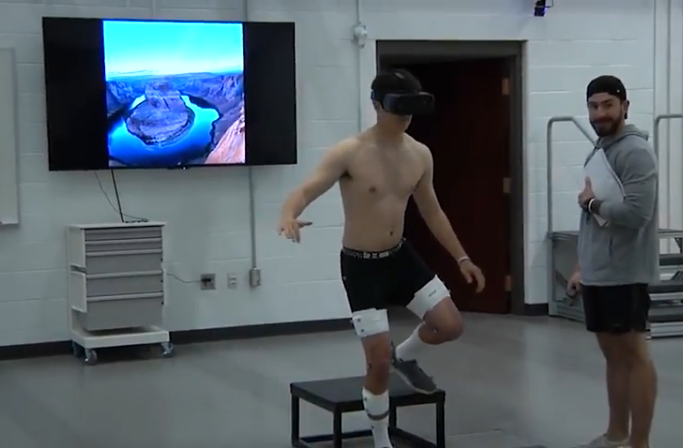ATHENS, Ohio – Virtual reality is leading to better ACL recovery, researchers at Ohio University say.
Associate professor Dustin Grooms , who specializes in biomechanics, has researched how an athlete’s brain changes after a ligament injury during sport. With goggles, cameras, two plates and a six-inch drop-off, Grooms can measure a lot what the eye can’t see.
“(The plates) take advantage of Newton’s Third Law of Motion, which is based on if you hit the ground, you get an equal and opposite reaction force that comes and hits you,” Grooms explained. “So we actually measure the force that the ground hits you with, but you hit the ground with the force, right? So it’s called a ground reaction force.”
Grooms, along with a few other newly hired professors, had a say in the nearly half-million dollar renovation to Ohio University’s Heritage College of Osteopathic Medicine (OUHCOM), which along with the two ground reaction force plates, are many high tech cameras to capture motion.
“The motion capture cameras use red light and they reflect off markers that we place at very precise anatomical landmarks, and we can essentially reconstruct you in the computer,” he said.
Having fun in the lab…Happy National Biomechanics Day from our lab! @Dusty_Grooms @jaeyom76 @JanetSimon51 #NBD2018 pic.twitter.com/fuaIeJKaFl
— NMBHAL_Ohio (@NMBHAL_Lab) April 11, 2018
Grooms also partners with the Ohio Athletic Department’s athletic training staff to help assist trainers with ACL recovery.
“We’ll bring them over and try to create rehab targets if a kid is not loading their joint well or not producing force,” he said.
“This allows us to capture things the eye can’t see,” Dustin Grooms, associate professor at Ohio University
Lab day with @OhioWBasketball! Getting better thru science. @Dusty_Grooms @JanetSimon51 @NMBHAL_Lab @daknotestine @Senaptec @Fitlight pic.twitter.com/WmbREaFt6X
— Christopher Miller (@ChrisMillerATC) July 26, 2017
Virtual reality comes in by putting a recovering athlete in a setting in which they’re familiar with, and puts them through drop tests by surrounding them with an environment instead of just closing their eyes. When the athlete does come back to sport, they are more acclimated to their surroundings.
All of this has to do with the brain and one’s vision. An athlete with a torn ligament loses proprioception, which is the sense of the relative position of one’s own parts of the body and strength of effort being employed in movement.
When an injury occurs, the proprioceptors get damaged too, so the brain relies on vision. Grooms explains, “The brain, to generate movement after an injury, rewires and it starts to use vision for movement then proprioceptor capability.”
Below are some infographics about ACL recovery from Bart Dingenen on Twitter.
Proud to see our @SportsMedicineJ paper on return to sport after #ACL reconstruction in 2 infographics! 🤩🔝
➡️ Let's move forward and optimize our rehabilitation approaches! 👊
For more details 👉📜👉 https://t.co/3NhYDw1p4d
Thanks @YLMSportScience 🙏👌 pic.twitter.com/wtyn4dAW3G
— Bart Dingenen (@BartDingenen) April 28, 2018
Grooms also assisted in the research that was developed to get U.S. Olympic Gold Medalist downhill skier Lindsay Vonn back to sport.
“When you’re Lindsay Vonn and skiing a thousand miles down a hill, you need all of your visual processing reaction time for that task,” he said. “You blow out your knee though, you do not have those proprioceptors, so your brain rewires to use vision.”
An athlete, with virtual reality, can then re-weight towards vision after an injury and not proprioception because that nerve sense is lost after injury.
How do you feel about virtual reality being used to prevent ACL injury? Comment in the section below. You can contact Jake Hromada on Twitter @JakeHromada


This is awesome!!! Thanks for visiting the lab Jake!!!